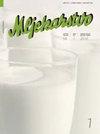Concentrations of retinol and carotenoids in Jersey milk during different seasons and possible application of the colour parameter as an indicator of milk carotenoid content
IF 1.1
4区 农林科学
Q3 AGRICULTURE, DAIRY & ANIMAL SCIENCE
引用次数: 1
Abstract
The aim of this study was to determine concentrations of retinol, β-carotene, lutein and zeaxanthin in Jersey milk during different seasons and their correlation with milk colour parameters. During a sixmonths period the Jersey cows (n=77) were kept free-stall and fed with total mixed ratio (TMR; farm season), for the next three months the cows were kept for four hours on pasture and the rest of the day free-stall fed with TMR (transition season), and for the remaining three months they were kept predominantly on pasture (grazing season). A bulk milk samples (200 mL) were collected during the last week of each month in the period between May 2018 and April 2019. Retinol and carotenoids concentrations in cow milk were quantified using high performance liquid chromatography, while milk chemical composition was analysed by a MilkoScan FT 120 infra-red analyser. The season significantly (P<0.05) affected chemical composition of milk, and the highest (P<0.05) content of milk fat, protein and non-fat dry matter was found during the farm season. Retinol, β-carotene, lutein and zeaxanthin concentrations (μg/100 mL) were as follows: 2.56±0.29, 4.15±0.27, 4.43±0.40 and 0.97±0.04. Lutein and retinol concentrations in Jersey milk were affected (P<0.05) by the season. The highest lutein concentration was found during the grazing season, while the farm season yielded the highest retinol concentration. Moderate and positive correlations (P<0.05) were found between β-carotene and lutein concentrations and colour parameter b*, resulting in a more intense yellow colour i.e. high values of colour parameter b*. The obtained results suggest that milk colour could be used to estimate carotenoid concentrations in milk.不同季节泽西牛奶中视黄醇和类胡萝卜素的浓度以及颜色参数作为牛奶类胡萝卜素含量指标的可能应用
本研究旨在测定不同季节泽西牛奶中视黄醇、β-胡萝卜素、叶黄素和玉米黄质的含量及其与牛奶颜色参数的关系。在6个月的时间里,将77头泽西奶牛(n=77)放在散养栏中,按总混合比(TMR;在接下来的三个月里,奶牛在牧场上饲养4小时,其余时间用TMR自由饲养(过渡季节),其余三个月它们主要在牧场上饲养(放牧季节)。在2018年5月至2019年4月期间,每个月的最后一周采集散装牛奶样本(200毫升)。采用高效液相色谱法对牛奶中的视黄醇和类胡萝卜素浓度进行定量分析,并用MilkoScan FT 120红外分析仪对牛奶的化学成分进行分析。季节对乳化学成分有显著影响(P<0.05),其中乳脂、蛋白质和非脂肪干物质含量以农畜季节最高(P<0.05)。视黄醇、β-胡萝卜素、叶黄素和玉米黄质浓度(μg/100 mL)分别为:2.56±0.29、4.15±0.27、4.43±0.40和0.97±0.04。不同季节对泽西乳中叶黄素和视黄醇含量有显著影响(P<0.05)。叶黄素浓度在放牧季节最高,而视黄醇浓度在农场季节最高。β-胡萝卜素和叶黄素浓度与颜色参数b*呈中等正相关(P<0.05),导致颜色更浓,即颜色参数b*值高。所得结果表明,牛奶颜色可以用来估计牛奶中的类胡萝卜素浓度。
本文章由计算机程序翻译,如有差异,请以英文原文为准。
求助全文
约1分钟内获得全文
求助全文
来源期刊

Mljekarstvo
Agricultural and Biological Sciences-Animal Science and Zoology
CiteScore
1.90
自引率
41.70%
发文量
18
审稿时长
12 weeks
期刊介绍:
Mljekarstvo is an open access, peer-reviewed international quarterly scientific journal. The first issue was published in 1951, by the Croatian Dairy Operators'' Association (today: Croatian Dairy Union, publisher). In a paper at a Union conference held 28 October 1951 in Zagreb it was said: "Our desire is that this magazine does not meet the fate of its predecessors, but that it continues to reflect the creative efforts and to provide guidelines for the producers as well as all other operators employed in the dairy industry."
It is our pleasure today to say that wishes of the enthusiasts who attended the conference have come true, and the magazine Mljekarstvo during the last six decades was a reflection of the creative efforts of numerous dairy scientists and experts, and through its texts it served as a guideline in improving production and processing of milk and dairy products. Mljekarstvo has been following all the achievements of the dairy profession in Croatia, and it also gives the short surveys of world achievements. The result of the research of local and foreign scientists and experts always find their place in the magazine Mljekarstvo. It has been edited by our outstanding dairy experts employed at colleges, research institutions and dairy companies.
 求助内容:
求助内容: 应助结果提醒方式:
应助结果提醒方式:


